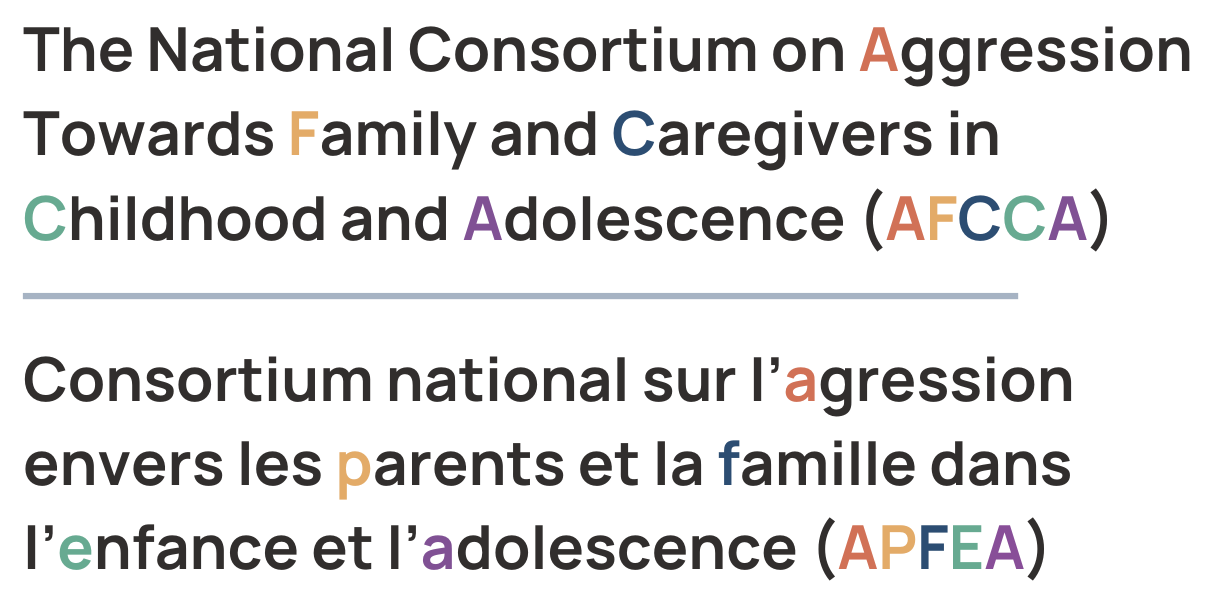what is AFCCA?
Aggression toward Family / Caregivers in Childhood & Adolescence (AFCCA) describes a pattern of behaviour in childhood or adolescence, characterized by aggressive behaviour by a child or adolescent toward family members or other caregivers. This causes significant harm (physical and/or psychological) to the child/adolescent, the person(s) the behaviour is directed toward, and other witnessing family members.
This stems from a common difficulty in which the child struggles to find co-regulation with the adult(s), resulting in progressive challenges with self-regulation.
AFCCA is most often directed to parents, primary caregivers, and siblings in the home, but can also be directed toward other caregivers in other settings. The behaviour commonly becomes entrenched and escalates over time.
weathering the storm
We sometimes refer to the concept of ‘weathering the storm’ as an analogy for understanding AFCCA.
The wind is a force of nature that is all around us, all the time. It's just there, a natural, accepted part of our environment.
Sometimes it manifests as a gentle breeze, with no visible trace of its existence. Sometimes it picks up speed and rustles the leaves on the trees. Sometimes it continues to build in intensity, but we still withstand its strength.
And sometimes, the wind becomes so unexpectedly strong it turns into something new-- a tornado that batters many of the things in its path and knocks people off their feet.
When the wind becomes a tornado, it is difficult to weather the storm alone. We pull out our emergency supplies that were built up in advance. We work to repair damage that has been done. We can be left feeling scared and traumatized by the experience.
We can look to our community for support and safety together in the storm. We connect with others to ensure everyone is cared for.
"Can you teach us to walk in the storm, instead of working to avoid it?"
- B, family advocate, parent with lived experience
recognizing AFCCA
Families who’ve shared their experiences with the National Consortium report ongoing / sustained behaviour that includes:
Physical harm or injury to others
Psychological harm or emotional injury to others
Threats to harm others
Angry/aggressive outbursts, language, posturing
Destroying property / damaging the home
Physical or psychological harm to self
Dangerous or risky behaviour outside the home (stealing, weapons, illegal drug use, etc.)
Families experiencing AFCCA commonly suffer immense (and unfounded) blame, shame, and stigma. Too often, they don’t seek help as a result which can lead to increasing safety risks, greater family instability, and potential for family breakdowns or disruptions.
AFCCA’s effect on families
AFCCA affects all members of a family, and those it’s directed towards. The child/adolescent themselves must be at the center of how we consider impact or harm. They themselves suffer guilt, shame, stigma, blame, and other psychological impacts from the lasting outcomes of AFCCA. The impacts ripple outwards from there, crashing into parents and caregivers, who deal with many of the same harmful effects, plus the additional layers of physical and psychological harm or injury. Extended family members, especially siblings in the home who are witnessing violence, suffer as well. Collectively, the impacts from AFCCA touch communities and society as a whole.
Impacts to the child/adolescent exhibiting AFCCA include:
escalating mental health issues
diminished self-worth
damaged family relationships and connections
criminalization of the child/youth
depiction as a violent perpetrator
entrenchment within the child welfare system
family instability / disruption
risk of entrenched behaviour into adulthood
Impacts to the parents, caregivers, and other family members experiencing AFCCA include:
significant risk of psychological and/or physical harm
escalating mental health issues
secondary trauma from exposure to violence
filial trauma
isolation from other family members and community
increased risk of marriage breakdown
family instability / disruption
job/work instability
financial strains (due to costs of caring for and supporting their child)
AFCCA’s effect on community and society
Families seeking help for AFCCA often report being directed to the child welfare system as a last resort.
Parents and caregivers commonly report their child entering / re-entering the child protection system (either through voluntarily placement or apprehension) as a result of AFCCA and the lack of effective family supports. This places a significant cost on the child welfare system, with the cost of ongoing specialized care required in foster home, group home, or residential placement settings.
There are systemic long-term risks to youth, and costs to society, that result from entrenched involvement with under-resourced and ill-equipped social systems, ie. children’s mental health, youth justice, and child welfare.
Related research recognizes that “childhood aggression is a strong predictor of adult crime and violence” (Childhood Externalizing Behavior: Theory and Implications, 2004, Journal of Child & Adolescent Psychiatric Nursing), contributing to the incidence of domestic violence and intimate partner violence, and representing a pressing societal need for violence prevention.
AFCCA’s contributing risk factors
Greater research is required to deepen our understanding of the underlying contributing factors to AFCCA, and frequently co-existing risk factors. In a 2021 national consultation with Canadian families and caregivers:
94%
of respondents identified 1 or more co-existing conditions or diagnoses that they felt influenced their child’s behaviour.
64%
identified 3+ co-existing neurodevelopmental conditions or disabilities.
28+
co-existing conditions, diagnoses, and/or disabilities were referenced by families
Most commonly referenced were anxiety, Fetal Alcohol Spectrum Disorder (FASD), Autism Spectrum Disorder (ASD), attachment / reactive attachment disorders, and sensory processing disorders.
Additional diagnoses referenced included developmental trauma, ADHD, learning disabilities, intellectual disabilities, and Oppositional Defiance Disorder.
Across biological, adoptive, and kinship families, parents / caregivers and youth themselves identified that adverse childhood experiences (ACE’s), as well as experiences of permanency and/or attachment disruptions are commonly present for youth exhibiting AFCCA.
Learn more
Read the Operational Definition guide to understanding AFCCA, which draws on published data, clinical reports and experience from practitioners, as well as insights from ongoing community engagement.






